Nevado Alpamayo
July 3-9, 2022
5947m
Cordillera Blanca, Perú
Nev. Alpamayo is not nearly the tallest nor the most prominent in Peru’s Cordillera Blanca, but has somehow gained the reputation of being the “most beautiful peak in the world”. In my opinion this status is completely subjective as the beautifulness is not something to be quantized or ranked, but in any case this is an extremely iconic and aesthetic peak and everyone has to agree with that. The pictures of Alpamayo’s SW Face from the high camp had gone viral on the internet in the past decade or two and this peak had become the most sought-after in the Peruvian Andes. It’s not uncommon to have 5+ parties sharing the route on the same day. 2022 has seemed to be a lucky year as the world’s still struggling with the pandemic and the associated travel restrictions. Catching Covid while travelling to Peru is still a real possibility so a lot of the climbers still choose to stay local in this year. I, on the other hand, was determined to climb some high-altitude peaks in this summer to be better prepared for the Himalayas in the following year. The Peruvian Andes is one of the few right places to go to in the summer months.
After committing to Peru I had to find a travel/climbing partner. I reached out to a handful potential candidates but only Lily signed up. I was initially thinking about some taller but easier summits such as Tocllaraju, but Lily (being a technical climber instead of a peak-bagger) convinced me to go straight for the best one. I wasn’t quite sure if I was ready for this climb as I had never even climbed on waterfall ice, but after watching some Youtube videos I decided to pull the trigger. The standard route involved 6-8 pitches of alpine ice at 65-85 degrees but it didn’t seem like one needed much of ice climbing techniques based on the videos I watched. To lead the equivalence of this climb at sea level would be a child’s play for Lily but what she lacked was the experience at higher altitude. I, on the other hand, was physically strong with decent high altitude experience but I lacked the technical skills, so the decision to hire a guide was then easily made. After talking to a few agencies I decided on Sergio from Nuestra Montañas and then we spent 1-2 months to communicate and formulate a customized plan. I insisted to plan (but not necessarily use and pay) additional days to accommodate the weather uncertainties and Sergio was able to understand. In addition to an IFMGA guide (William) we also hired one porter/cook (Juanito), an additional porter (Julio) and 5 donkeys/horses and their driver. The approach to just the base camp involved over 20 km at 4000 m altitude so the additional support would mostly likely be needed for all but the fittest. Neither Lily nor myself belongs to that category and in retrospect I have to say that without the porters and the guide the chance of us two pulling off Alpamayo was essentially zero. This was a 7-day expedition and the cost for using these supports was 3710 US dollars for the two of us plus ~15% tips. For guided expeditions in the global scale I consider this as “cheap” but you can also easily see that it’s definitely not a dirtbagging game.
This peak can be done in 6-7 days but that’s assumed one’s fully acclimatized. The best way to acclimatize is to climb smaller peaks so Alpamayo wouldn’t be the first one in this trip. The other peaks had their separate trip reports so here I’m only showing the acclimatization schedule.
- Day 1: Lima (sea level) – Huaraz (3100m)
- Day 2: Laguna Wilcacocha (3700m), back to Huaraz
- Day 3: Cerro Cachijirca (5000m), back to Huaraz
- Day 4: Nevado Mateo (5150m), back to Huaraz
- Day 5: Rest Day
- Day 6: Huaraz – Yanapaccha base camp (4800m)
- Day 7: Yanapaccha (5460m), back to Huaraz (3100m)
- Day 8: Rest Day
- Day 9-15 – Alpamayo climb…
I also need to emphasize that this guided service covered all transportations, group gears and all food such that we only needed to bring our own sleeping bags, pads, ice tools, crampons, harnesses and boots. For boots I opted to use Scarpa Phantom 6000 while Lily used La Sportiva G5. We both brought Western Mountaineering -32C sleeping bags as we both sleep cold, but such proved to be completely overkill. The temperature at high camp and on the summit day was no colder than a standard winter day in SW BC’s Coast Range. For ice tools each of us used one Quark and one Nomic but in retrospect two Quarks per climber should be sufficient enough. For crampons we both went with technical ice climbing crampons (mine being Petzl Lynx) and we did not regret this decision.

On the first day the team gathered in Hotel Santa Cruz at 7 am and after stuffing in a huge breakfast in the hotel we were on the road. Unlike on Yanapaccha we had a bigger van to carry all gears and people and the drive to Alpamayo’s trail-head in Cashapampa took over 3 hours. We firstly went all the way north past Caraz and then turned onto smaller dirt roads that never seemed to end. The trail-head was actually lower than the hotel at 2900 m elevation. Lily and I loaded most of our gears in two duffle bags for the donkeys and carried only 20-L day-packs for the several days’ trekking-in. The first day’s objective was Llamacorral at under 3800 m and the hiking took several hours. There’s minimal worth documenting as we just needed to follow the guide putting one foot in front of another. We hiked through a deep canyon gaining elevation rapidly and the temperature was decently hot. Once arriving at Llamacorral William informed us to just relax and rest while watching them to set up the tents. They erected two massive basecamp tents in addition to two sleeping tents. The hot water/coffee/tea was always ready and the meal was quite luxurious.

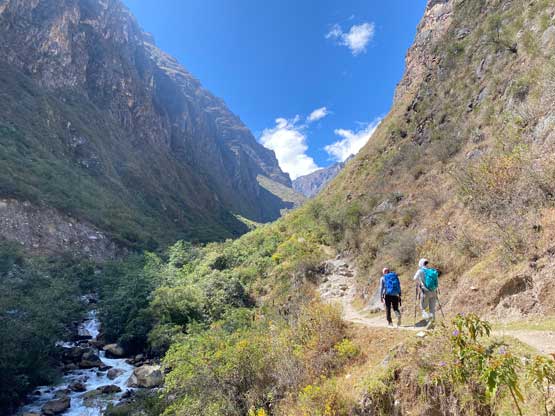
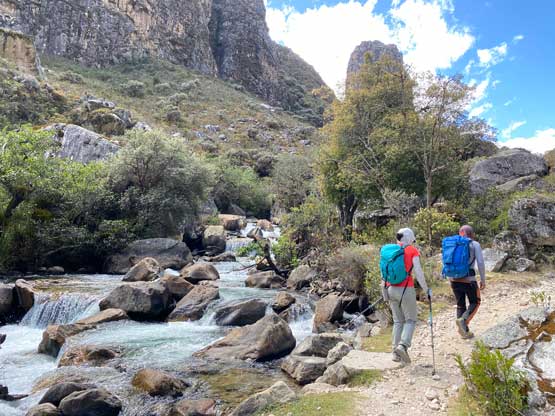

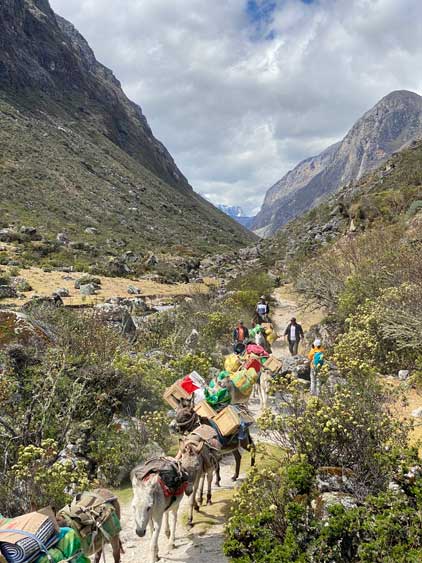

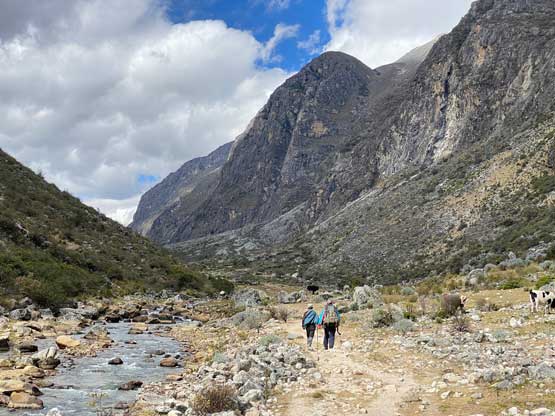


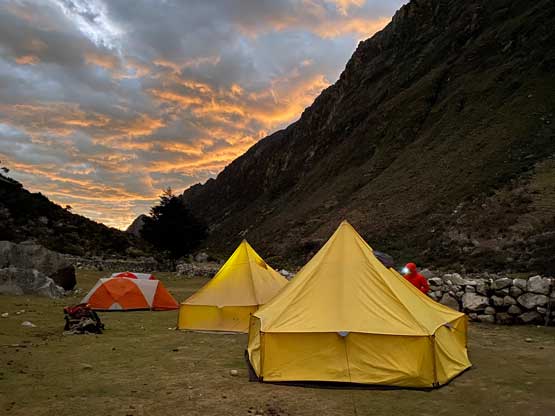
The next morning we got up at 7 am and got going half an hour later. Lily and I only needed to eat the breakfast made by the cook and pack our day-packs. William, Lily and I left the campsite while the porters and the donkey driver would take down all tents and catch up to us later. This day’s objective was the base camp at 4300 m. The elevation gain was less than Day 1 but the distance was considerably longer. We had almost 10 km of slog on flat terrain and the hiking was rather boring. The scenery wasn’t too bad, but the tone was monotonous. We plodded past an alpine lake and eventually arrived at an important fork where we turned left (northwards). A series of switchbacks later we plodded into Arhuaycocha valley with Alpamayo finally in sight. What we saw wasn’t the fabled side of this peak. The sight was still darn impressive but not enough for us to understand why it was the “most beautiful peak”. Later we learnt that the reputation was earned from the other valley. I think we hiked about 3-4 hours in this day and we arrived in Base Camp even before noon. I would have suggested to hike to Moraine Camp at 5000 m in the afternoon, but we decided to just stick to the pre-planned schedule. The weather was the best on Day 5 which was our planned summit day anyway, so there’s no need to rush. I was also not new to killing time in these long and slow expeditions.


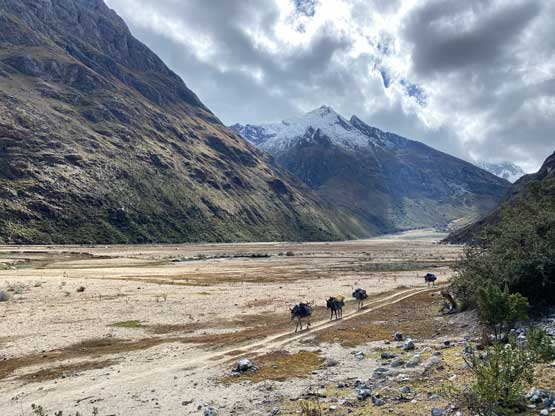

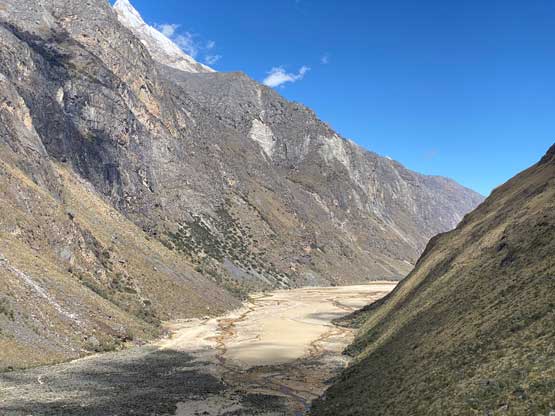

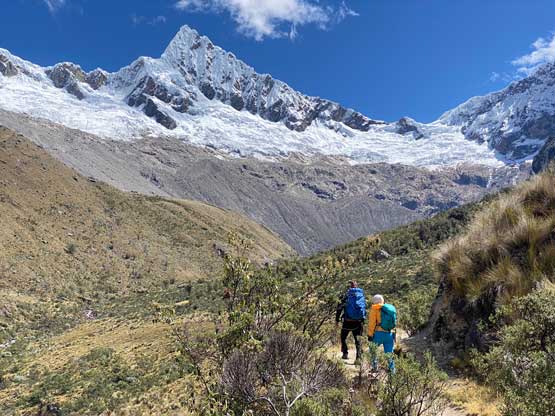
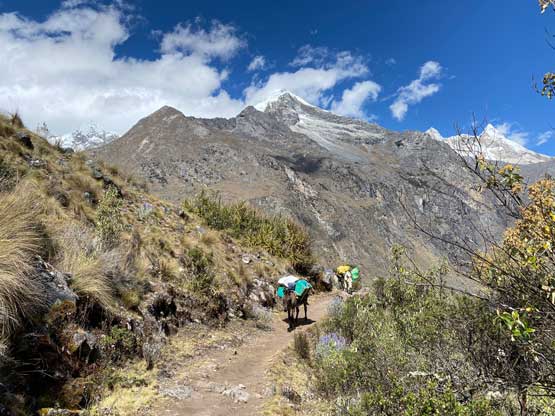
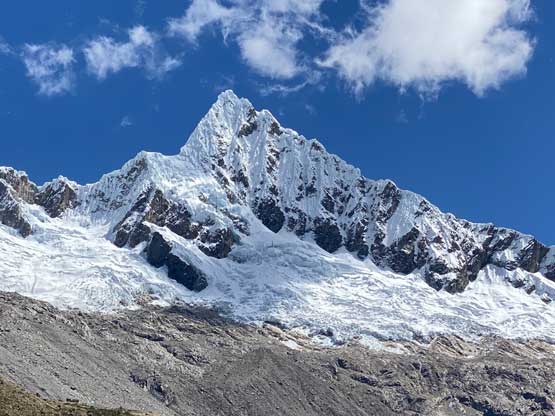
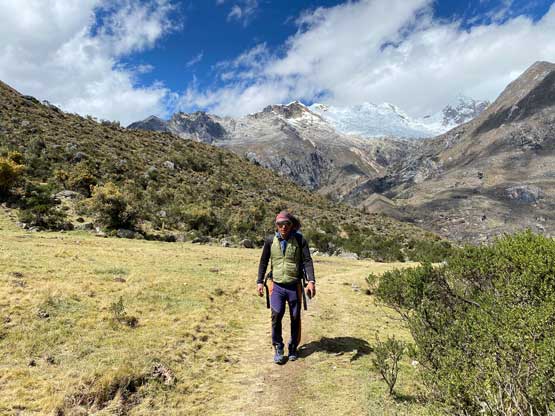
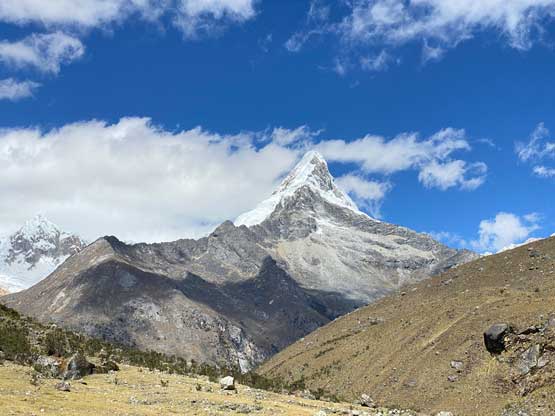

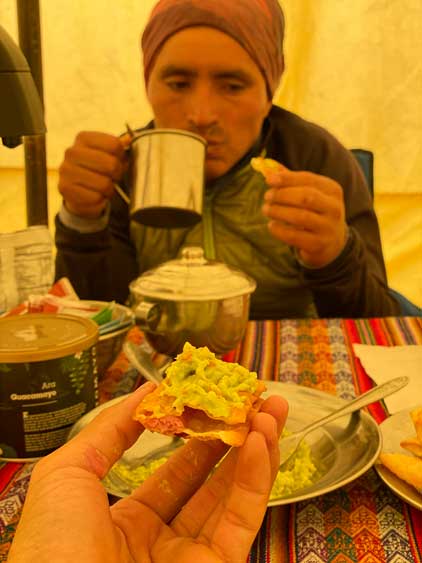
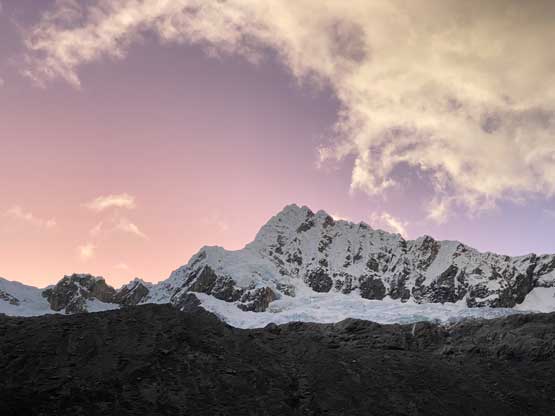

Day 3 of the expedition was even shorter but the transition in the morning took forever. The carry from base camp to Moraine Camp had to be done without the donkeys. As agreed prior to the trip Lily and I would only carry our day-packs to conserve energy for the summit push, whereas William, Juanito and Julio would carry the rest of the weight with each of their pack weighing over 80 lb. It turned out that the pack weight was a bit too ridiculous so the donkey driver volunteered to also carry some of the loads for us. After having one last luxurious lunch William guided Lily and I leaving about half an hour earlier than the rest of the group but unlike the previous two days they didn’t manage to catch up to us until the campsite. It took us just under 2 hours to plod up the steep trail to the camp at just under 5000 m elevation. We waited for more than half an hour and the three of them eventually showed up. The weather was mostly cloudy with intermittent snow squalls but the sky eventually cleared in the evening revealing some incredible views.




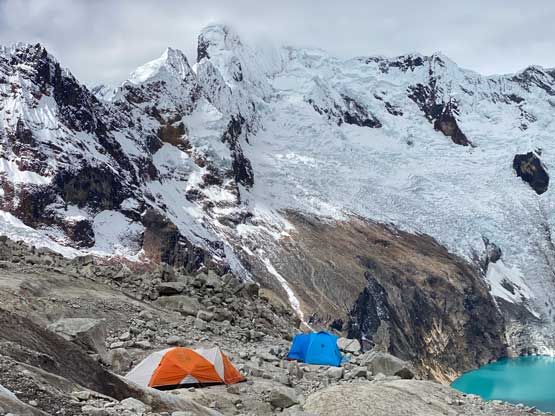
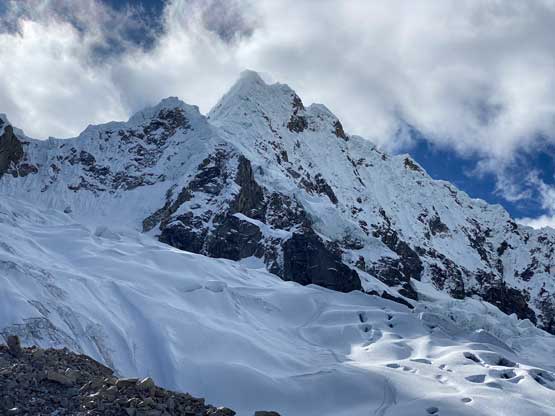
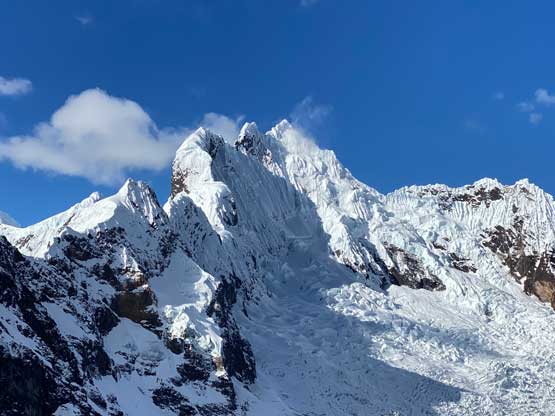
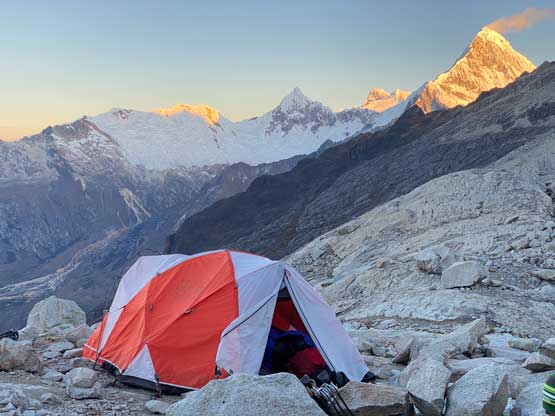
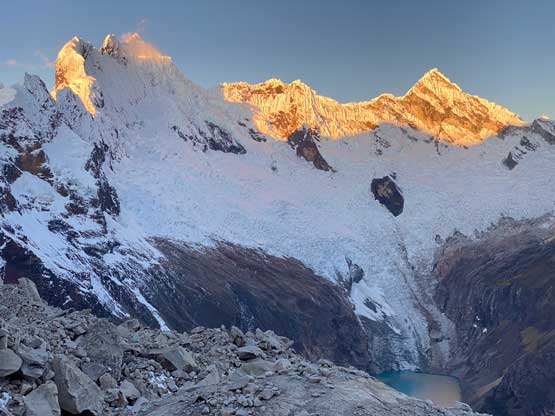
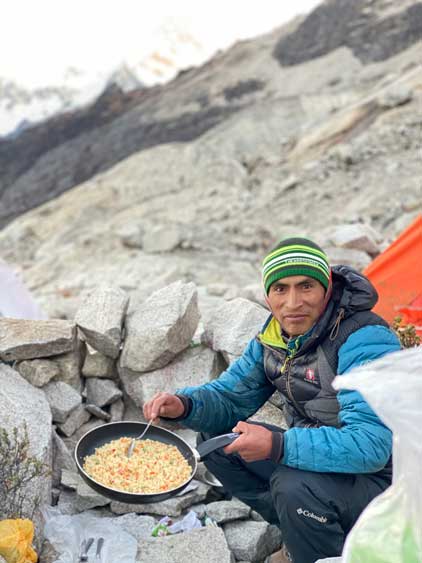

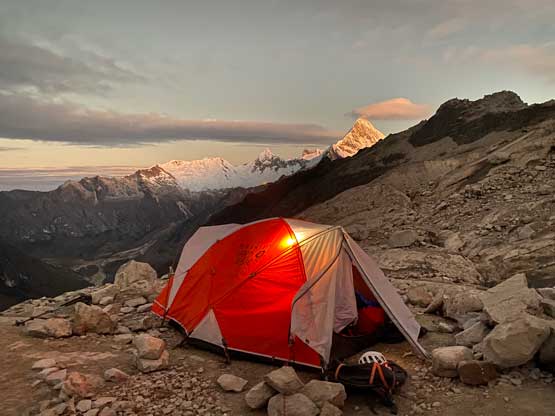

The 4th day’s mission was to carry to the high camp at 5500 m but this time the donkey driver wouldn’t be with us. He had already descended to the base camp to be with his donkeys in the previous day. This didn’t mean we would end up carrying more weight as the ascent to the high camp was on technical terrain so we all had to wear boots and crampons and the ropes were also out. The traverse to the edge of the glacier was a bit shitty with mostly hopping on unstable boulders and once there we took a lengthy break donning gears. The glacier looked incredibly daunting but with William guiding us I tried not to worry too much. It turned out that all we needed was to plod one foot in front of another following the existing tracks, which were rather a “highway”. We trended far to the climber’s right before making some zig-zags around large crevasses to the base of the technical sections under Alpamayo/Quitaraju col. William informed us that we had under 150 m gain to the col and we had to take the second ice tool out. We ended up not needing to belay each other but there’s at least one solid pitch of hard snow or soft ice at over 45 degrees. Juanito and Julio were struggling on that stretch due to their heavy packs so the three of us eventually passed them at the last pitch. The final pitch to the col was rather trivial on 40-degree snow. There were already 5+ tents perched at the high camp.
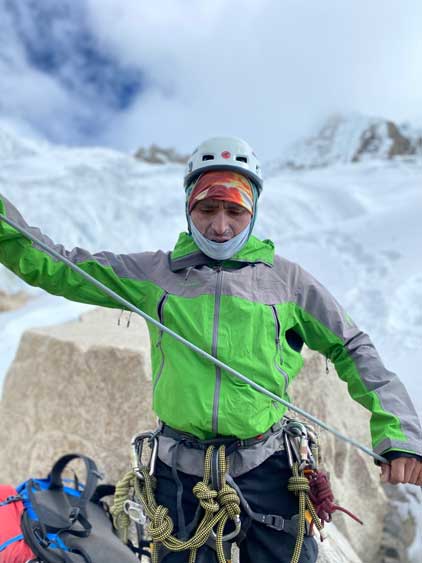

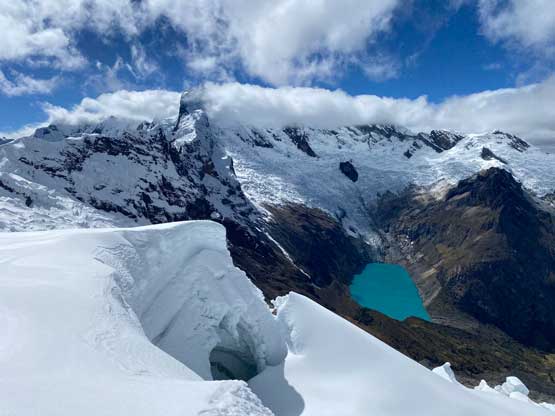
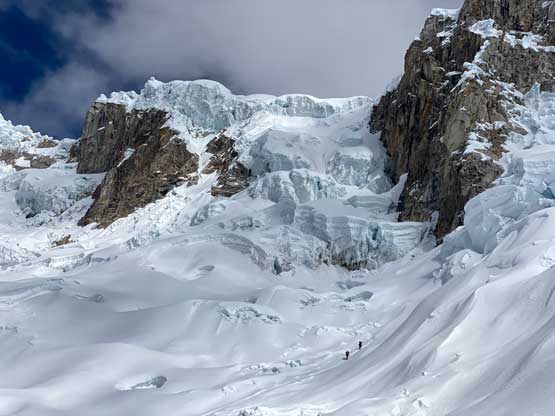
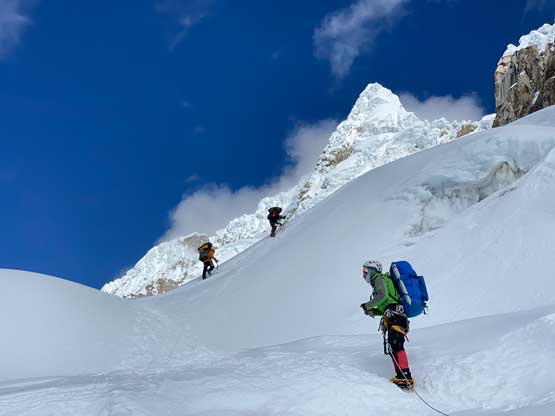
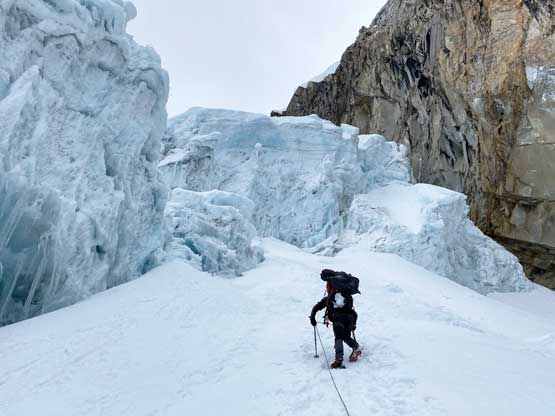

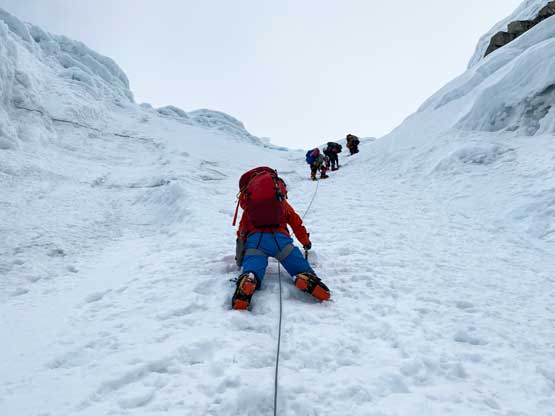

It took us at least 1-2 hours to set up all the tents and to get the hot water going and by that time the other group-of-four had already finished their descent. The weather was not good on this day but they summitted nonetheless in mostly white-out conditions. They informed us that the conditions were great and we also knew the weather next day was supposed to be better, so the stoke was high. Despite the crowded high camp only two groups (including us) were going to attempt the summit on the next day so we also didn’t need to worry about the crowding on the route, which was greatly appreciated. The other group was an independent team-of-two whereas a Chilean girl with her guide was going to wait out another day for their summit attempt. The sunset show from this high camp was as epic as people had made it sound like on the social medias and I stayed outside the tent for the entire show, taking well over 300 photos despite the coldness. Needless to say this was probably the most scenic campsite I’ve ever seen. I also need to mention here that the route on Alpamayo changes from year to year. Prior to the pandemic the standard route was the “French Direct” or the central couloir on SW Face that goes straight up to the summit, but after the pandemic this couloir had been blocked by a gigantic serac/cornice on the summit. In 2021 nobody had climbed the direct couloir and it seemed like nobody would have done so neither in 2022. In 2021 some guides opened a route one or two couloirs to the left of the direct. The climb was in similar difficulty but 2 pitches shorter and they only stopped on the summit ridge leaving the true summit unattained. This year, the route was more-or-less the same with only smaller variations due to the bergschrund, but guides had opened the route to the true summit.



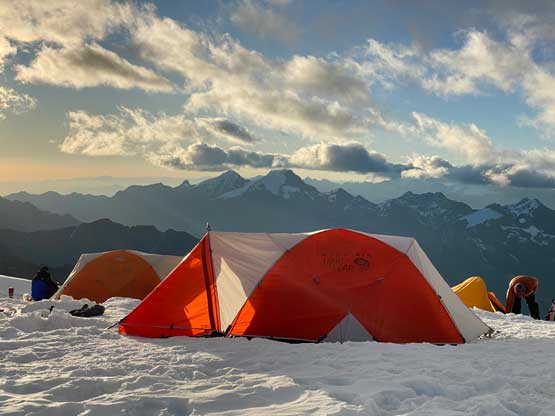
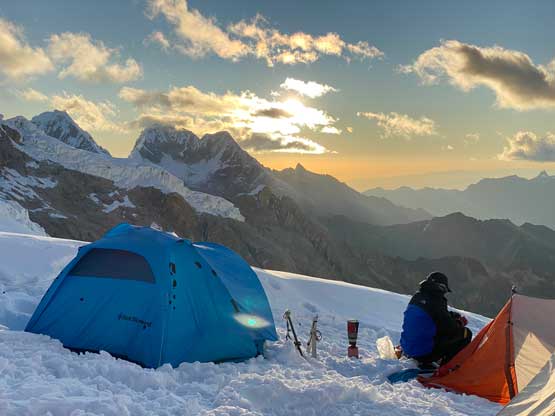




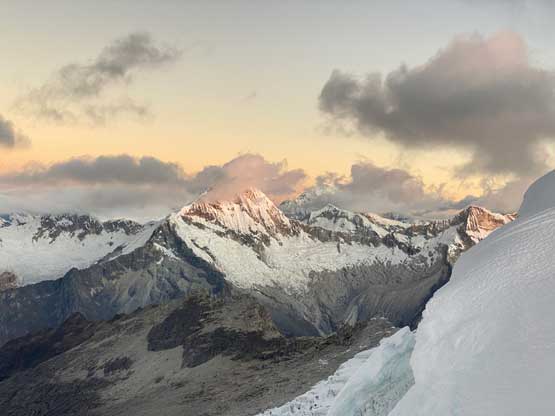
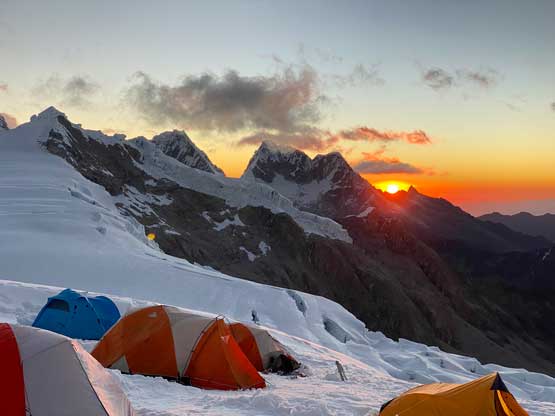

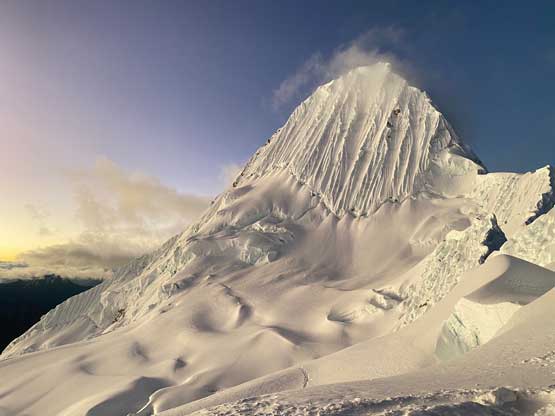


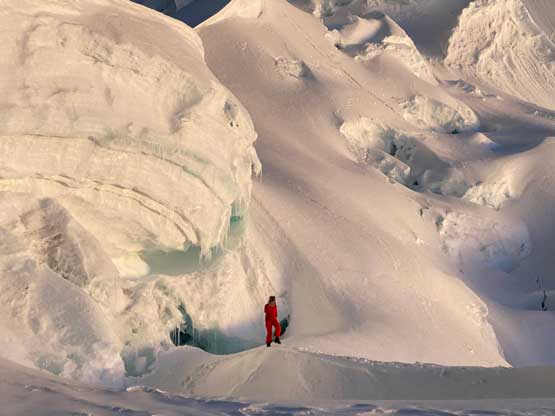


As usual for the Peruvian guides William informed us to get up at 12:30 am and as a result I only managed less than one hour’s sleep. I got of the tent into a thick fog layer thinking we were totally screwed but ten minutes later the fog dissipated revealing starry skies. An hour later we all had stuffed in some frozen breads with gems and off we went. I ended up leading us descending over 50 m elevation to the basin under Alpamayo’s SW Face with one interesting jump across a bottomless crevasse. William then took over the lead to guide us towards the base of the climb. We gained elevation slowly but steadily. In the darkness there wasn’t much to see but we climbed some steep snow to the bottom of an overhanging bergschrund, which proved to be the crux for many groups. The snow was extremely unconsolidated as every time I stepped away from the existing tracks I would post-hole knee deep. William led the first (easy) pitch climbing diagonally out to the climber’s right to the only possible spot to cross the ‘schrund, that required using a picket to aid an awkward step-across. William did it with ease and gave us a top-rope belay from above. Lily, being a shorter person couldn’t even reach that picket but she could just grab the rope to pull herself up. The step-across was also too wide so I gave us a push from behind. This move eventually ended up stopping the team behind us, and one more team the next day. Ninja moves on steep snow were rather my strength so I easily reached out the picket, crossed, cleaned the picket and joined the rest of the group at the station of pitch 2.

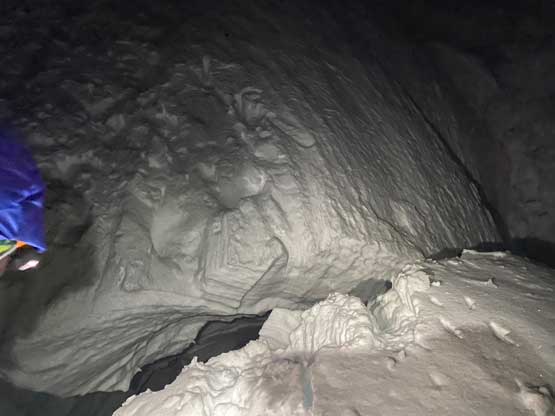
The third pitch William led a traverse out to the left into the couloir’s fall line and then angled hard right onto insanely steep snow. The snow in this part of the Andes could easily stick onto 65+ degrees faces without being avalanched off, largely due to the unique climate and possibly the altitude. About two more pitches of steep snow using pickets as protection the angle had increased to 65 degrees and then we hit ice. From this point onward we would have 4-5 more pitches of alpine ice at 65-75 degrees but the ice was not the same as I expected. Due to the high volume of traffic there were already “steps” developed offering regular rest-spots, so it wasn’t really a continuous and tiring front-pointing game. The ice was also quite soft that most of the time I didn’t even need to drive the ice tools too hard. At least 50% of the ice tool placements of mine were done similar to climbing on steep snow. The difficulty was mostly resulted from the physical aspect due to the altitude and the long and sustained nature of this route. Throughout pitch-by-pitch climbing the three of us had got into a rhythm. William would lead out in front belaying the two of us on two separate ropes. William did not need to build belay stations as there were plenty existing ones to use. I would follow up cleaning all the pros William placed including pickets, screws and sometimes just quick draws clipped into existing v-threads. My second job was to take as many pictures and videos as possible as I had that extra time to do so but I did have to be extremely careful not to drop and lose the phone. The last two pitches were particularly steep as we ascended into a narrow chimney. Lily said that here’s only spot that she needed “a bit” of ice climbing techniques. We eventually topped out onto the summit ridge at around 8 am in the morning. We were doing great on time, so I told William that we should traverse to the true summit as that mattered to me.
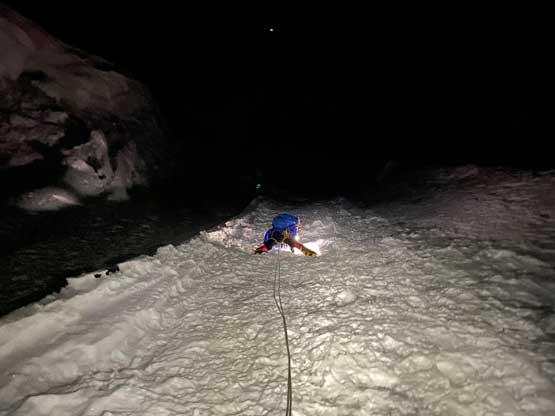
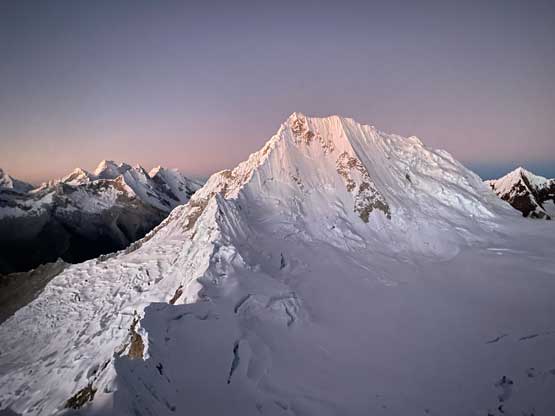
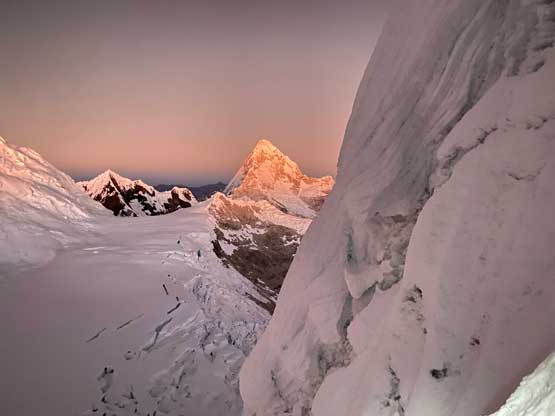
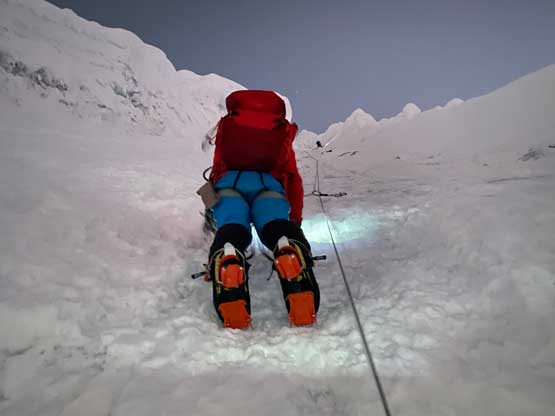
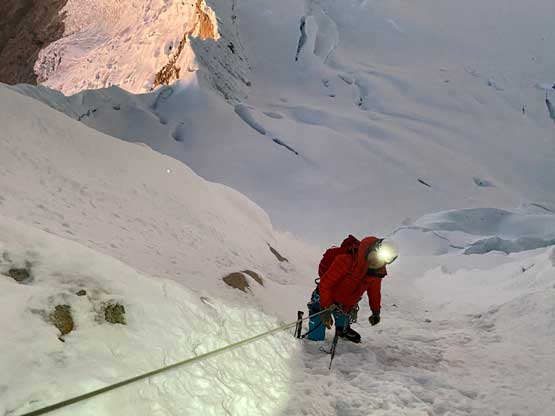
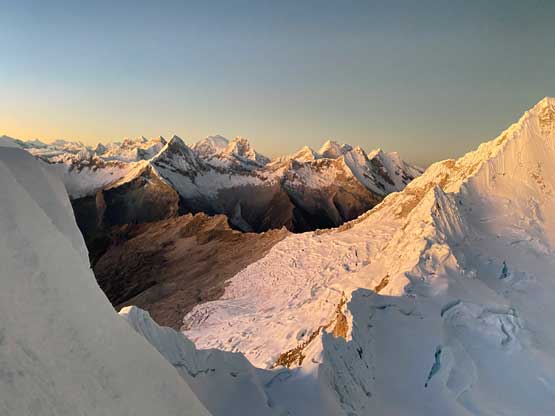
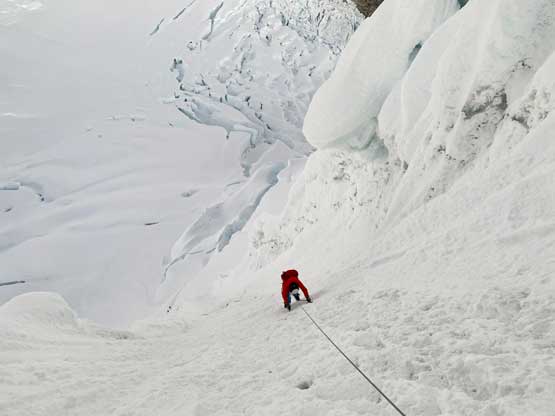
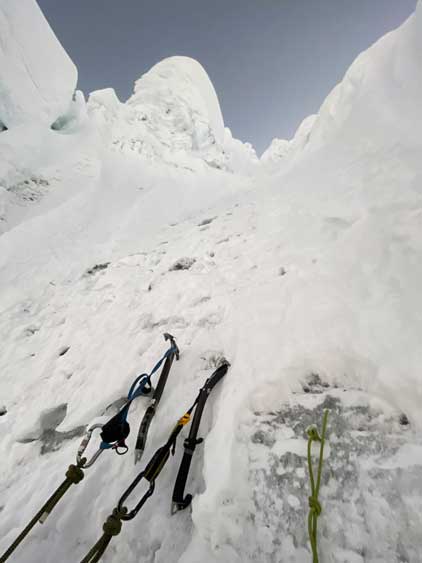


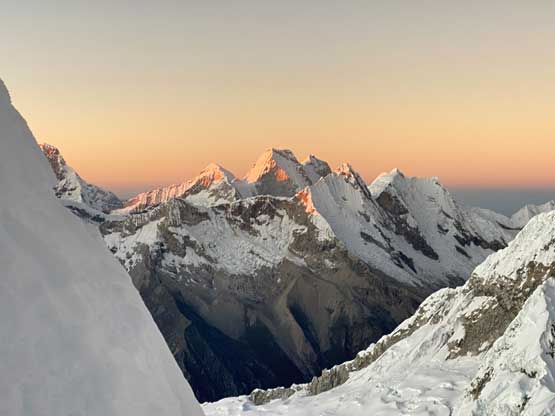
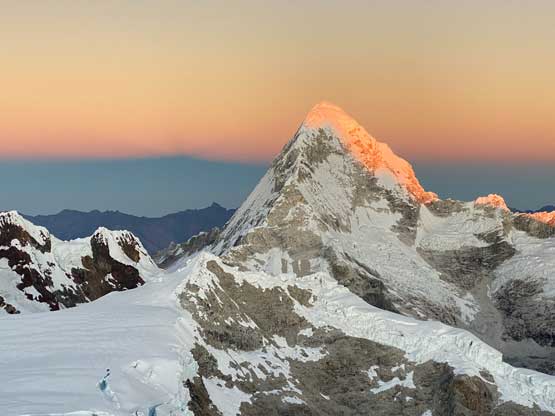



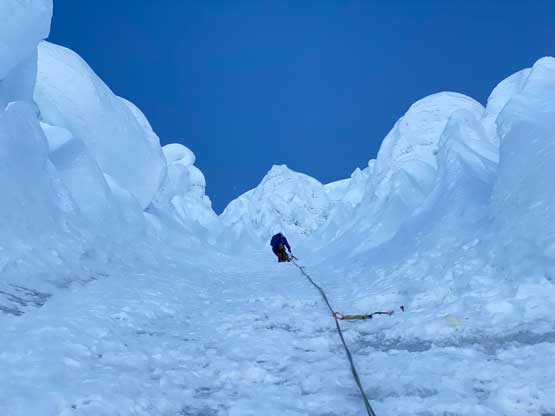

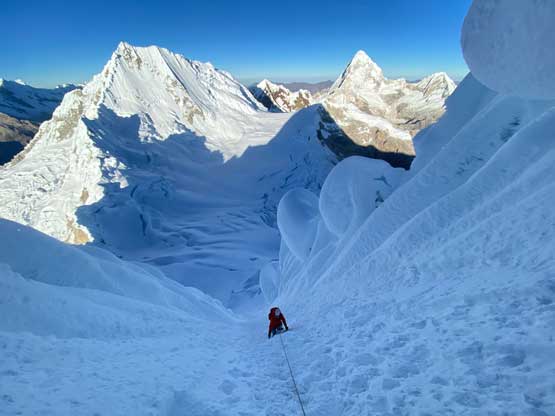


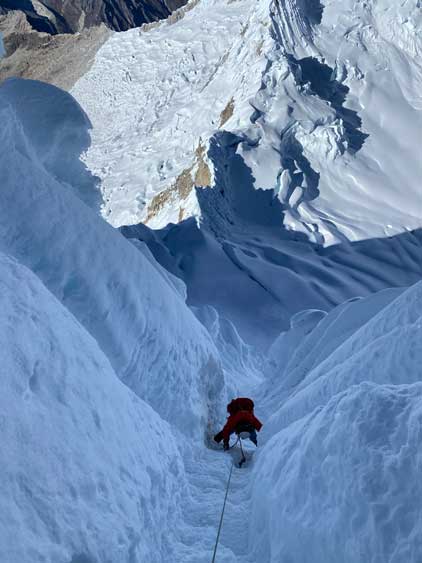


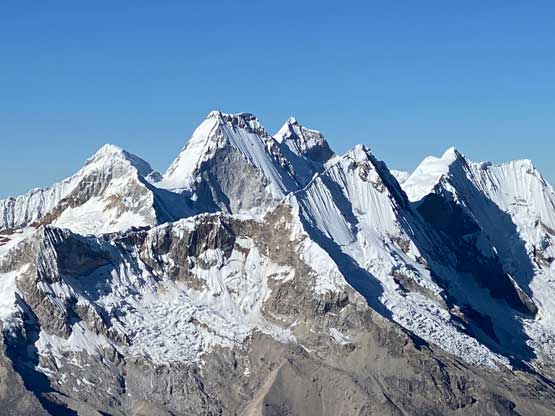
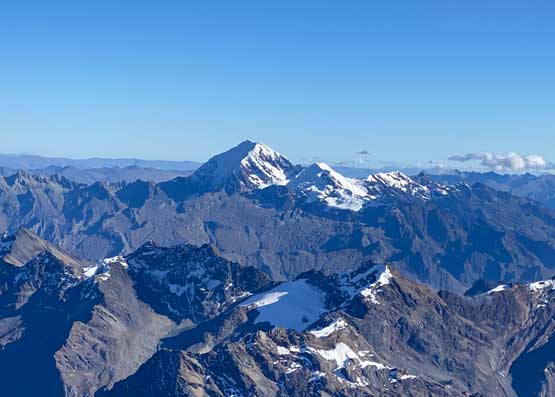

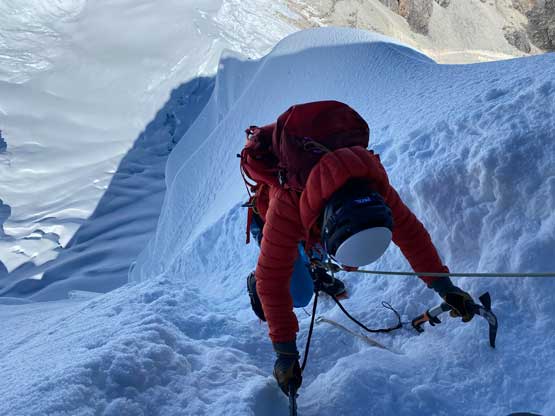
The traverse to the true summit appeared daunting but ended up much easier than we thought. There’s only about half a pitch that required facing into the slope whereas the rest was just walking. That half a pitch did feel very exposed. In short time we were all done with the difficulties and the final pitch onto the summit was a rather victory walk. From the true summit we could see the tents at high camp so that meant the guys down there could also see us. This was definitely a monumental moment in my career. Reaching the summit of Alpamayo had been on my dream for years and now we had just pulled it off with very minimal drama. I did have to say that I had been sick for the whole trip since back in Vancouver so I was never sure, but I’m not someone to easily give up on things.
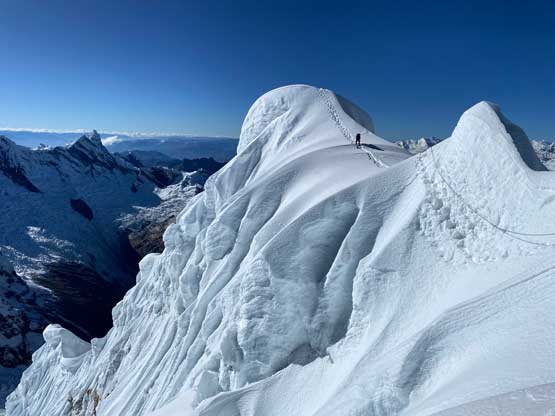

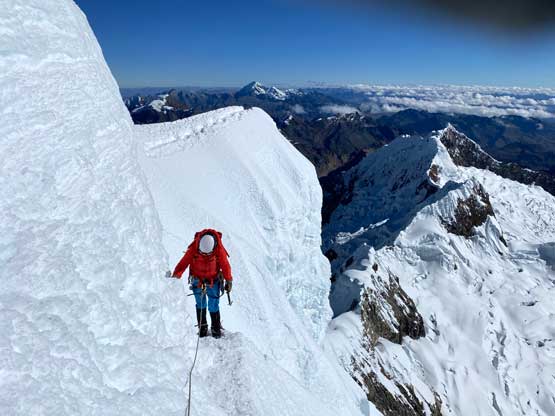




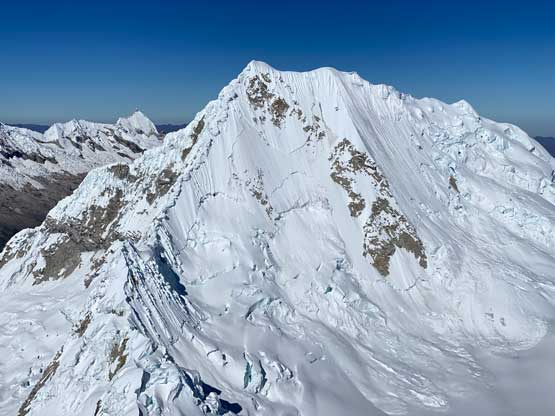
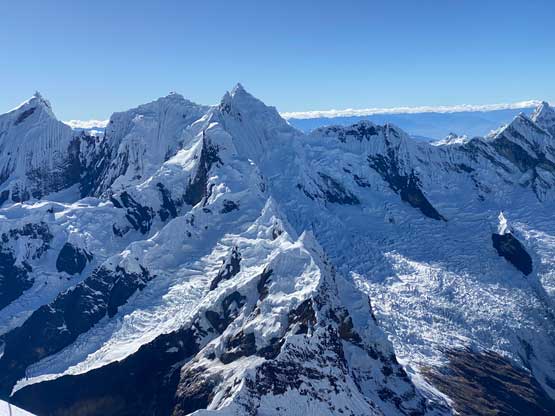
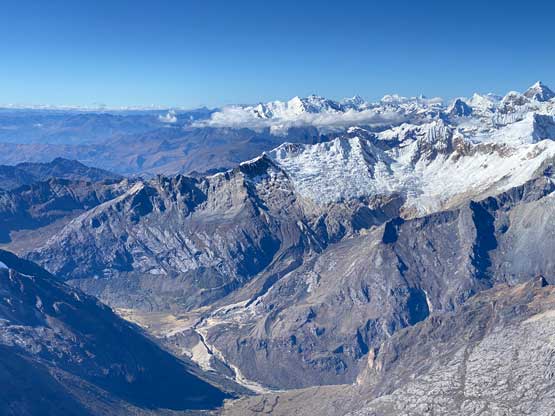


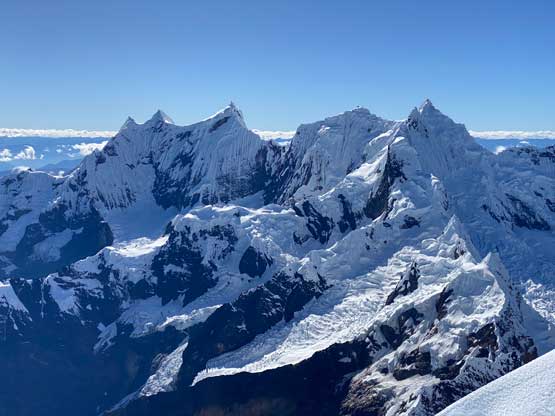


Reversing the summit ridge traverse was quite trivial and here William snapped an epic photo of Lily and myself on the ridge. The three of us had done two rappels on Yanapaccha so the rhythm was already built. William would lead the line down to find the next station and I would rappel at the tailing end to collect the back-up gears. About 7 rappels later we were at the bergschrund. The rappel over the ‘schrund was overhanging and fun but I was already too spent to enjoy that. By this point the clouds had engulfed the peak so I didn’t bother to take more photos. The slog back to the camp was extremely exhausting thank to that 50-m elevation regain. We ended up plodding at literally a snail’s pace and crawled back to the tents where everyone else congratulated us. It also appeared that my health issues from the sickness prior to this trip would only become worse at the altitude so a few hours later I made the hard decision to pull the plug on Quitaraju. Lily didn’t have that desire to climb that mountain neither, so the decision was to skip a day and descend the follow day. Ideally I wanted to get down as soon as possible but everybody was exhausted so I was fine to spend another night at the high camp. We finished the climb at 1:30 pm so we definitely had the time to descend to base camp, but oh well. Part of me wanted to experience more of this camp anyway.

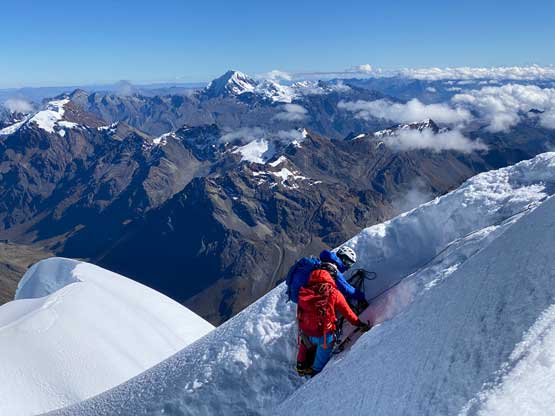

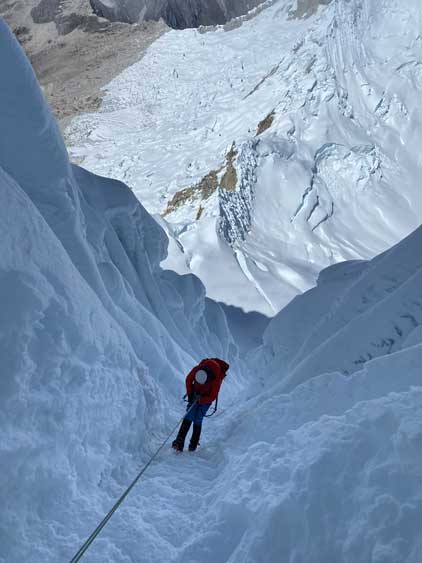
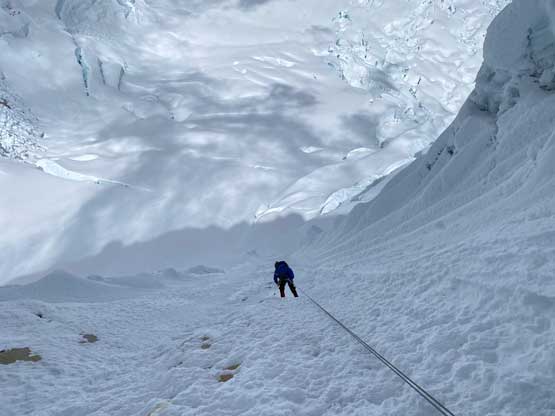


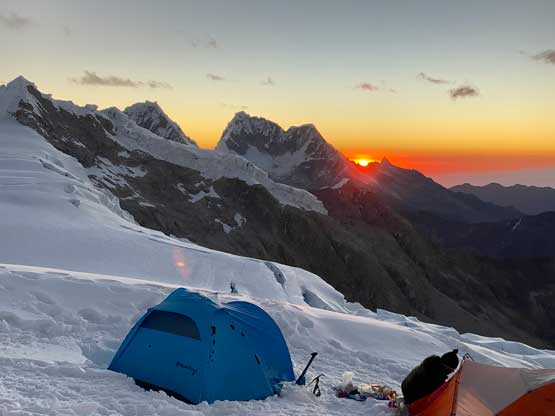

The morning of Day 6 I was the first one to get out of the tent and the sun beams hadn’t even shone on us yet. I shivered and waited for half an hour for the sunbeams and once the tents were lit up everyone else got out. The morning views made the extra night at high camp worthwhile, but the breads were completely frozen solid and very difficult to eat. Lily was smart enough to have hauled an extra package of Mountain House and kindly shared some with me, and that saved my breakfast. For those not willing to chew frozen breads I highly recommend bring one or two packages of Mountain House to let the cook prep for the morning. Three groups were climbing the route on this day and one had already turned back at the bergschrund. The Chilean girl was halfway up the face at a much slower pace, whereas the third group was already on the true summit, about an hour faster than us.
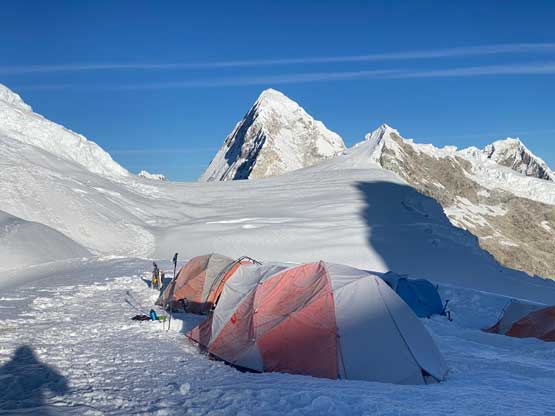
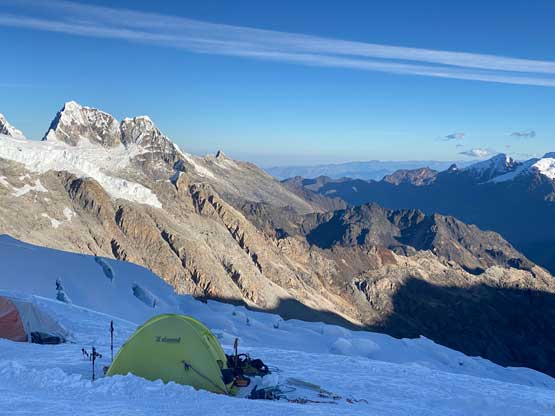


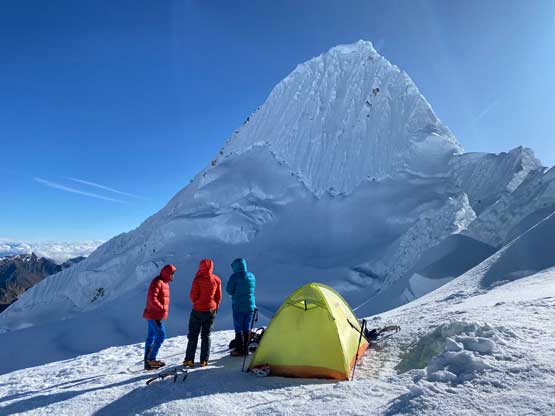

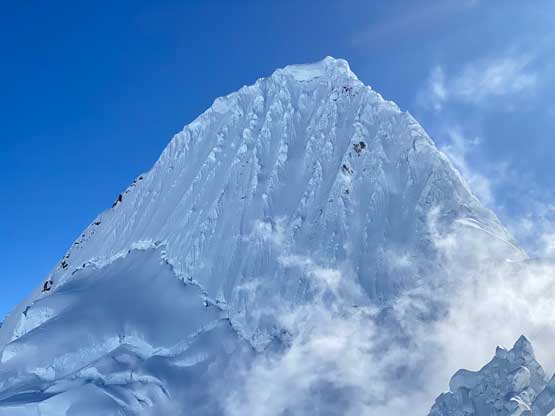
After packing the camp William guided the 5 of us rappelling two times to get off the technical terrain immediately under Alpamayo/Quitaraju col and then we slogged off the glacier in a single push without any stop. We took a long break at the edge of the glacier and then hopped the boulders back to Moraine Camp. Without the donkey driver this time Lily and I would have to carry more weight but we no longer had to conserve energy at this stage so it really didn’t matter. We then descended to the base camp in another single shot without having to stop to rest, and the rest of this day was spent relaxing and killing time at the base camp.

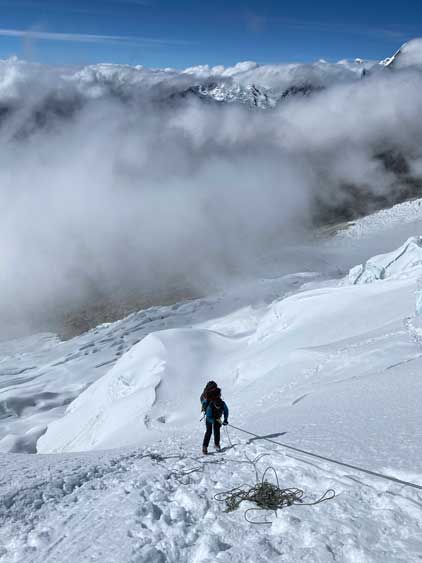
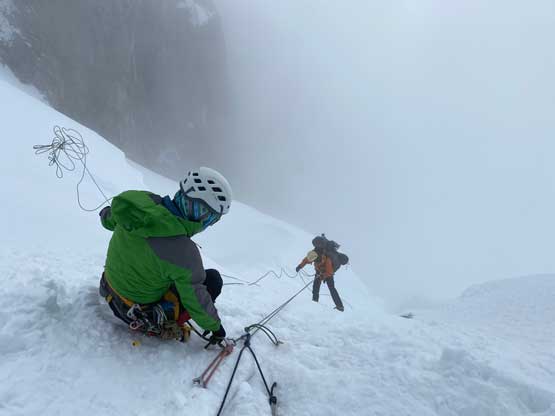
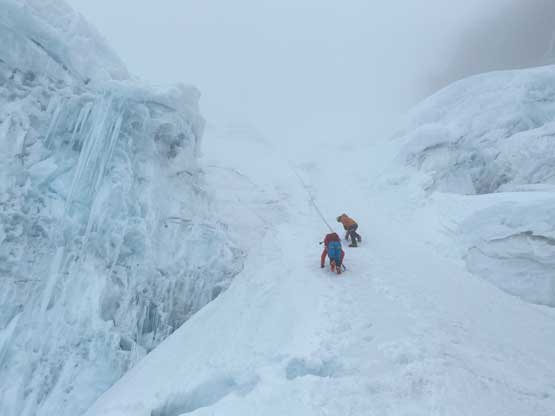
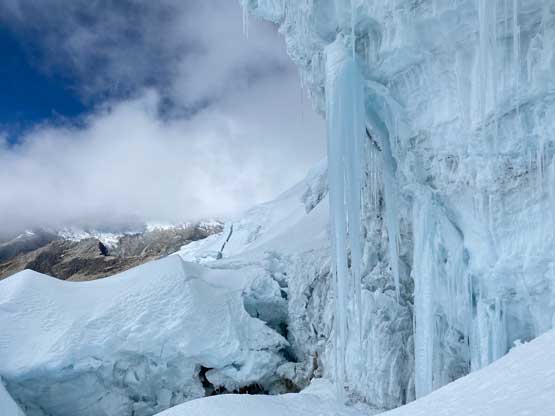

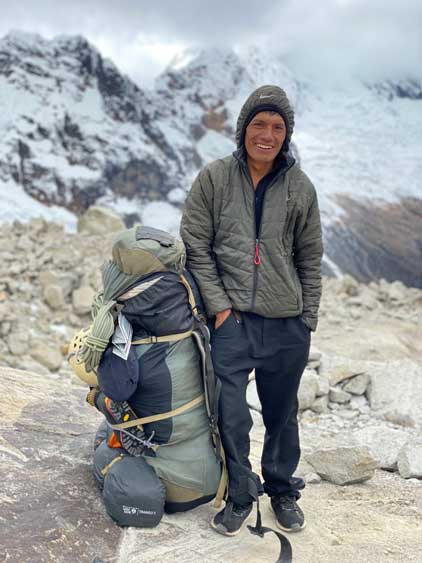

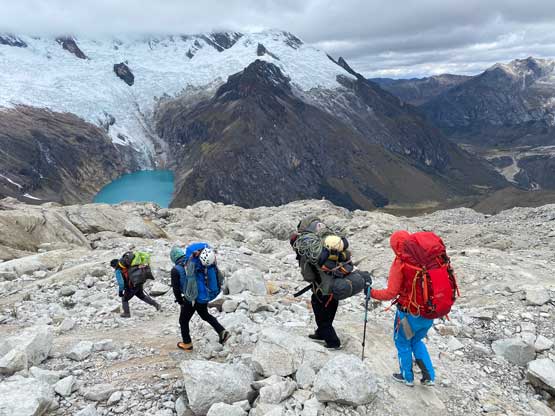


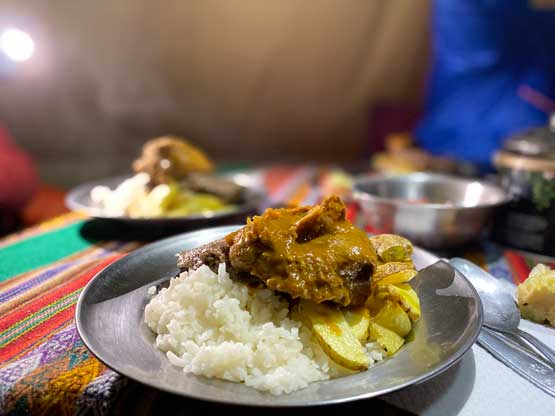

The objective of Day 7 was to slog all the way out from Base Camp to Cashapampa losing 1500 m elevation and covering about 25 km distance. We knew it’s going to be a slog so we started earlier. The weather had significantly downgraded by this point and it even rained on us on the first hour of trekking. Once getting down to the main valley the rain had gave way to sunshine but the clouds had always engulfed the higher peaks. There’s actually not much worth documenting as the three of us somehow got into a racing mode to plod faster and faster. We eventually even caught up to Juanito and Julio who were not even carrying anything and eventually we finished at lunch time. We then had a well-deserved meal at Cashapampa before piling into the van for the long drive back to Huaraz, where Sergio was patiently waiting. The next two days were spent in Huaraz to rest but with still a week of time in Peru we had to make some decision. My coughing didn’t really allow me to climb another big peak but I could possibly climb an easier 5000 m like Vallunaraju, but that peak just didn’t sound too attractive at this point. Lily then threw out the possibility to do some tourism things in southern Peru. What I cared was whether I could bag some peaks in those tourism spots and the answer was yes, so the decision was made to fly to Juliaca to check out Lago Titicaca.

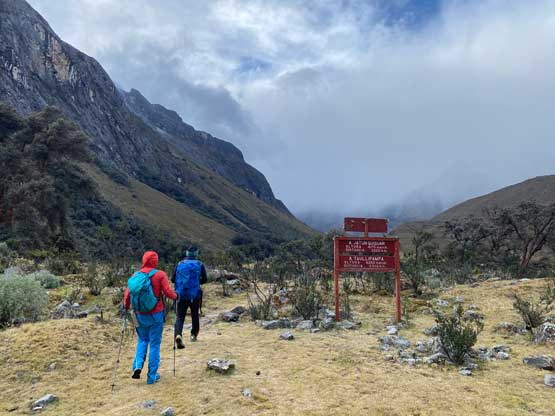

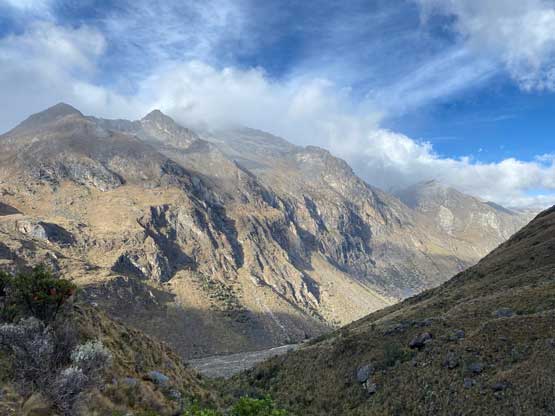
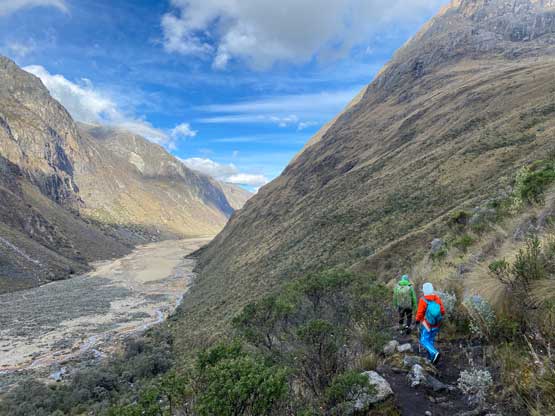

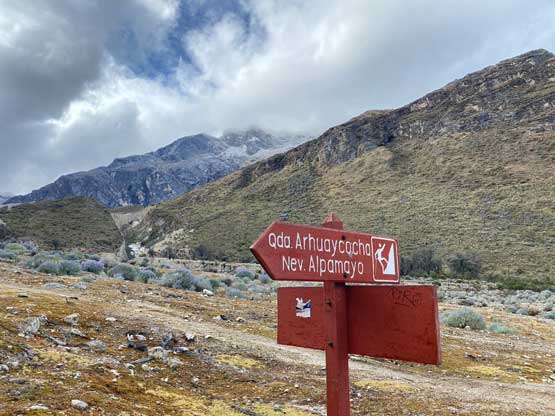





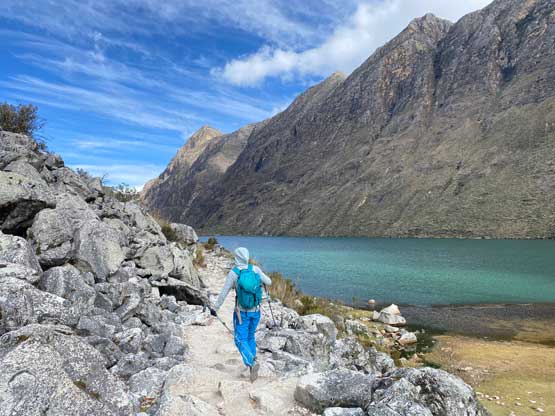
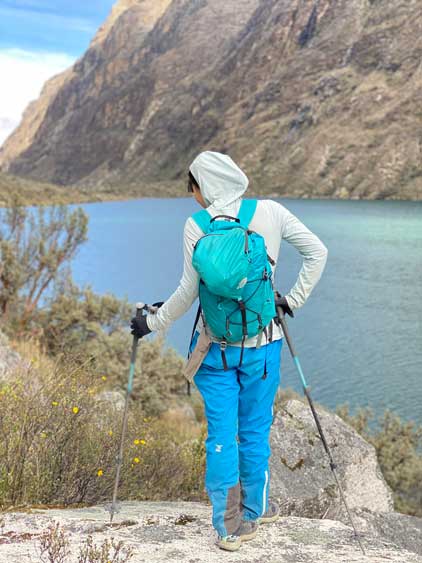
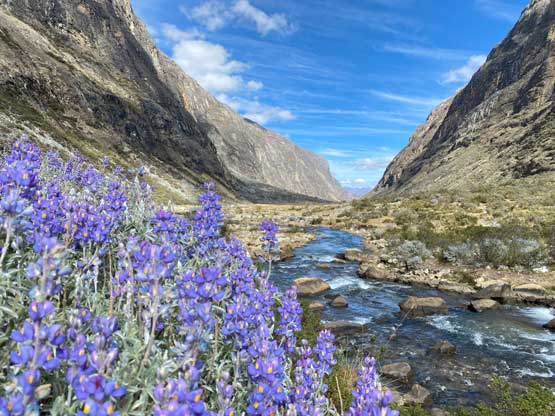

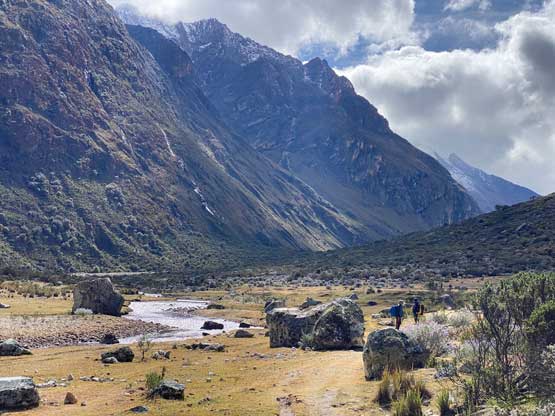
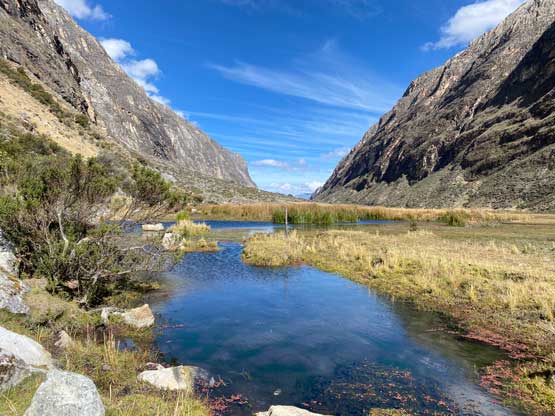
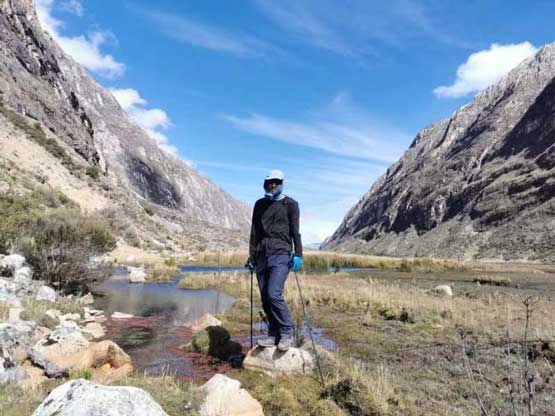

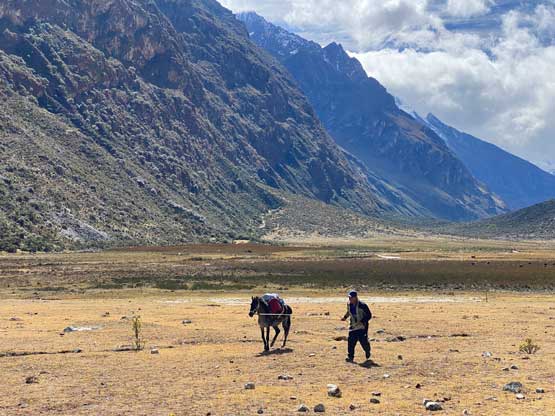
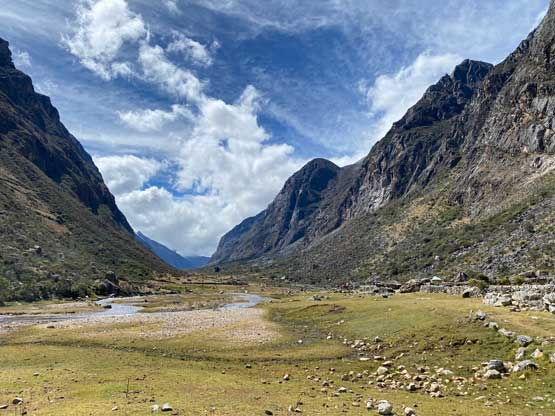

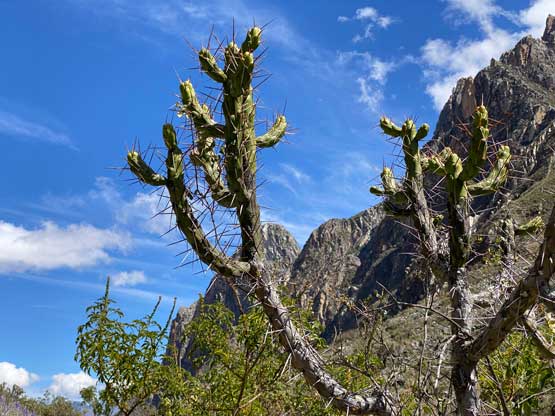



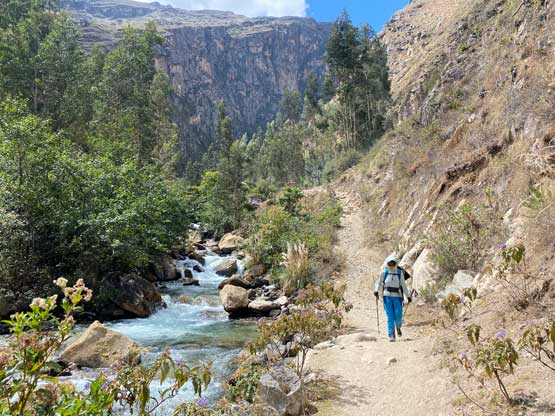

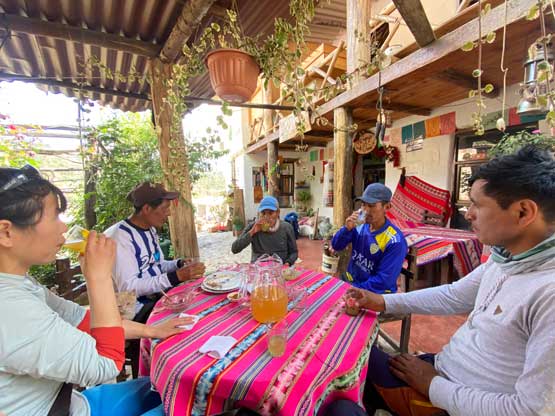
Finally I’m sure most of you reading this TR aren’t actually going to climb this peak but some of you are here for beta, so here’s some additional points to take note of.
- Ice climbing experience to FOLLOW up this route? I guess yes, but you don’t have to be a WI5 climber….
- Steep snow experience? Absolutely essential… In fact you mostly use steep snow techniques on this route…
- Do NOT underestimate the physical challenge. If you can carry 40lb pack at sea level it doesn’t mean you can do so at 5000 m altitude.
- Temperature – prepare for -20C but no worse than that. Most likely you’ll have temperature -10C on the summit day.
- There’s no helicopter rescue in Peru. If you get injured up there you are seriously fucked. Others had to carry you down (if there are people around). In short words, getting injured is NOT an option.